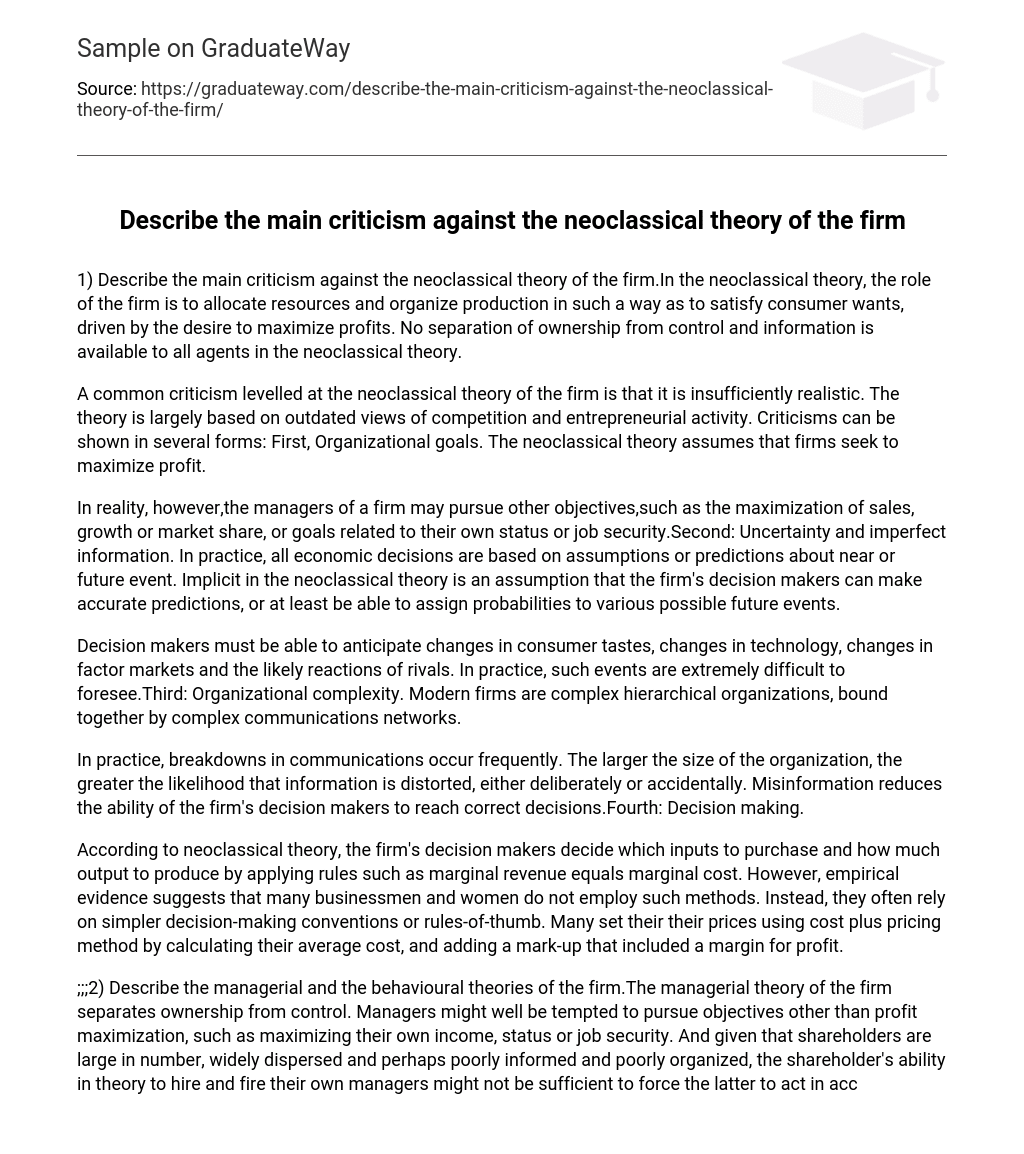1) Describe the main criticism against the neoclassical theory of the firm.In the neoclassical theory, the role of the firm is to allocate resources and organize production in such a way as to satisfy consumer wants, driven by the desire to maximize profits. No separation of ownership from control and information is available to all agents in the neoclassical theory.
A common criticism levelled at the neoclassical theory of the firm is that it is insufficiently realistic. The theory is largely based on outdated views of competition and entrepreneurial activity. Criticisms can be shown in several forms: First, Organizational goals. The neoclassical theory assumes that firms seek to maximize profit.
In reality, however,the managers of a firm may pursue other objectives,such as the maximization of sales, growth or market share, or goals related to their own status or job security.Second: Uncertainty and imperfect information. In practice, all economic decisions are based on assumptions or predictions about near or future event. Implicit in the neoclassical theory is an assumption that the firm’s decision makers can make accurate predictions, or at least be able to assign probabilities to various possible future events.
Decision makers must be able to anticipate changes in consumer tastes, changes in technology, changes in factor markets and the likely reactions of rivals. In practice, such events are extremely difficult to foresee.Third: Organizational complexity. Modern firms are complex hierarchical organizations, bound together by complex communications networks.
In practice, breakdowns in communications occur frequently. The larger the size of the organization, the greater the likelihood that information is distorted, either deliberately or accidentally. Misinformation reduces the ability of the firm’s decision makers to reach correct decisions.Fourth: Decision making.
According to neoclassical theory, the firm’s decision makers decide which inputs to purchase and how much output to produce by applying rules such as marginal revenue equals marginal cost. However, empirical evidence suggests that many businessmen and women do not employ such methods. Instead, they often rely on simpler decision-making conventions or rules-of-thumb. Many set their their prices using cost plus pricing method by calculating their average cost, and adding a mark-up that included a margin for profit.
;;;2) Describe the managerial and the behavioural theories of the firm.The managerial theory of the firm separates ownership from control. Managers might well be tempted to pursue objectives other than profit maximization, such as maximizing their own income, status or job security. And given that shareholders are large in number, widely dispersed and perhaps poorly informed and poorly organized, the shareholder’s ability in theory to hire and fire their own managers might not be sufficient to force the latter to act in accordance with the shareholders’ interests.
Managers might not wish to depart form owners’ objective for various reasons. Firstly, shareholders might dismiss managers if the managers are perceived to running the organization badly. Secondly, The firm might be vulnerable to a takeover if underperforming. Thirdly, if the firm relies on external sources of finance, its managers may face additional constraints in the form of scrutiny by lending institutions.
Moreover, Baumol suggests that the managers of a large firm are primarily interested in maximizing their organization’s sales revenue, subject to satisfying a minimum profit constraint.;Highest level of Revenues (Sales).This is what a manager would like to achieve if not constrained;;;;;;;;;;;;;;;;;;This figure illustrates Baumol’s sales revenue maximization model by using short-run cost functions and assume that the fixed cost is zero. The profit function, denoted?, is difference between total revenue(TR) and total cost(TC).
Therefore?=0 at the points where TR=TC. Profit maximization is achieved by producing the output level q1, at which the vertical distance between TR and TC is maximized. In the absence of any effective shareholder control, the firm’s managers might attempt to maximize sales revenue. Sales revenue maximization is achieved by producing the output level q3, at which the TR function is maximized.
However, the need to satisfy the minimum profit constraint shown by the horizontal line?MIN , prevents the managers from increasing output as far as q3. Sales revenue maximization subject to a profit constraint of?MIN is achieved by producing q2, the highest output level that is consistent with? ??MIN.;;The behavioural theory of the firm defines the firm in terms of its organizational structure and decision-making processes. The boundaries of the firm are defined quite loosely, to include all individuals or groups with influence or interests int he organizaion’s activities.
The behavioural theory recognizes that all decision making takes place in an environment of uncertainty, or bounded rationality. No individual or group has complete information about every aspect of the firm’s activities and operating environment. But all groups and individuals have some information, and the information they have tends to be most complete in the immediate vicinity of their own activities. Accordingly, decision making is based on bounded rationality rather than global rationality.
All decisions are influenced by the beliefs, perceptions and aspirations of the individuals and groups involved. Differences in beliefs, perceptions and aspirations create the potential for conflict within the organization. Conflicts are resolved through a bargaining process, from which corporate goals or objectives emerge. The resolution of conflict through bargaining between groups of stakeholders is achieved using side payments and facilitated by the existence of organizational slack which, in normal conditions, allows parties to receive rewards over and above the level necessary to prevent them from withdrawing their participation and support from the organization.
;;3) How can a firm be described in terms of transaction costs?Transaction costs are incurred when using market to allocate resources.They include the search costs associated with gathering information about relative prices; the costs incurred in negotiating the contract taht specifies the terms of the transaction; and costs that are created artificially by the government,through the levy of sales taxes or the imposition of quotas. A firm can be seen as an organization that consciously internalizes transactions creating savings in cost. Entrepreneurial abilities,such as the ability internalize transactions, might define the boundaries of a firm.;;





